Graduate Diploma in Early Childhood Education
VerifiedAdded on 2022/08/23
|9
|1874
|14
AI Summary
Contribute Materials
Your contribution can guide someone’s learning journey. Share your
documents today.
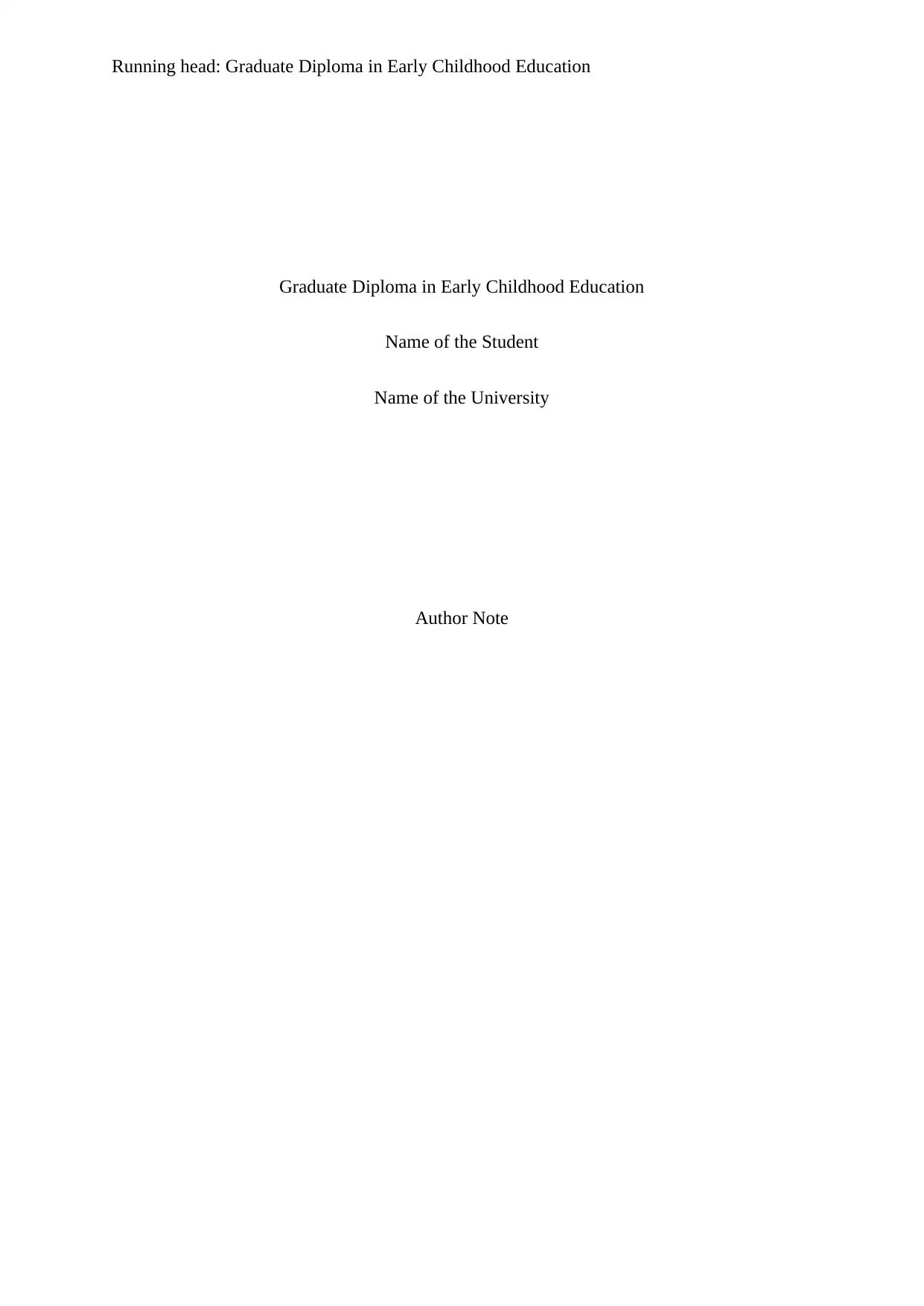
Running head: Graduate Diploma in Early Childhood Education
Graduate Diploma in Early Childhood Education
Name of the Student
Name of the University
Author Note
Graduate Diploma in Early Childhood Education
Name of the Student
Name of the University
Author Note
Secure Best Marks with AI Grader
Need help grading? Try our AI Grader for instant feedback on your assignments.
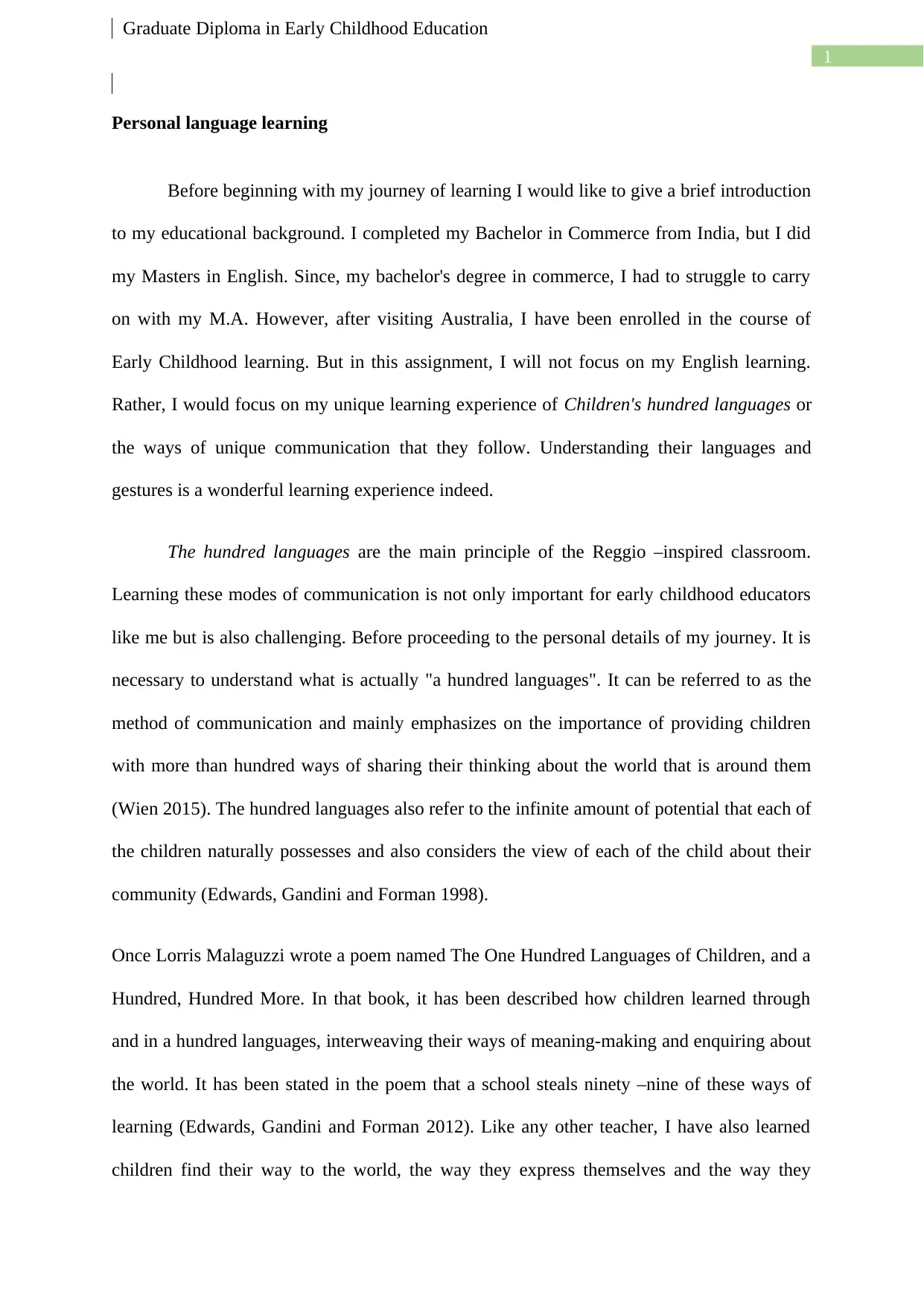
1
Graduate Diploma in Early Childhood Education
Personal language learning
Before beginning with my journey of learning I would like to give a brief introduction
to my educational background. I completed my Bachelor in Commerce from India, but I did
my Masters in English. Since, my bachelor's degree in commerce, I had to struggle to carry
on with my M.A. However, after visiting Australia, I have been enrolled in the course of
Early Childhood learning. But in this assignment, I will not focus on my English learning.
Rather, I would focus on my unique learning experience of Children's hundred languages or
the ways of unique communication that they follow. Understanding their languages and
gestures is a wonderful learning experience indeed.
The hundred languages are the main principle of the Reggio –inspired classroom.
Learning these modes of communication is not only important for early childhood educators
like me but is also challenging. Before proceeding to the personal details of my journey. It is
necessary to understand what is actually "a hundred languages". It can be referred to as the
method of communication and mainly emphasizes on the importance of providing children
with more than hundred ways of sharing their thinking about the world that is around them
(Wien 2015). The hundred languages also refer to the infinite amount of potential that each of
the children naturally possesses and also considers the view of each of the child about their
community (Edwards, Gandini and Forman 1998).
Once Lorris Malaguzzi wrote a poem named The One Hundred Languages of Children, and a
Hundred, Hundred More. In that book, it has been described how children learned through
and in a hundred languages, interweaving their ways of meaning-making and enquiring about
the world. It has been stated in the poem that a school steals ninety –nine of these ways of
learning (Edwards, Gandini and Forman 2012). Like any other teacher, I have also learned
children find their way to the world, the way they express themselves and the way they
Graduate Diploma in Early Childhood Education
Personal language learning
Before beginning with my journey of learning I would like to give a brief introduction
to my educational background. I completed my Bachelor in Commerce from India, but I did
my Masters in English. Since, my bachelor's degree in commerce, I had to struggle to carry
on with my M.A. However, after visiting Australia, I have been enrolled in the course of
Early Childhood learning. But in this assignment, I will not focus on my English learning.
Rather, I would focus on my unique learning experience of Children's hundred languages or
the ways of unique communication that they follow. Understanding their languages and
gestures is a wonderful learning experience indeed.
The hundred languages are the main principle of the Reggio –inspired classroom.
Learning these modes of communication is not only important for early childhood educators
like me but is also challenging. Before proceeding to the personal details of my journey. It is
necessary to understand what is actually "a hundred languages". It can be referred to as the
method of communication and mainly emphasizes on the importance of providing children
with more than hundred ways of sharing their thinking about the world that is around them
(Wien 2015). The hundred languages also refer to the infinite amount of potential that each of
the children naturally possesses and also considers the view of each of the child about their
community (Edwards, Gandini and Forman 1998).
Once Lorris Malaguzzi wrote a poem named The One Hundred Languages of Children, and a
Hundred, Hundred More. In that book, it has been described how children learned through
and in a hundred languages, interweaving their ways of meaning-making and enquiring about
the world. It has been stated in the poem that a school steals ninety –nine of these ways of
learning (Edwards, Gandini and Forman 2012). Like any other teacher, I have also learned
children find their way to the world, the way they express themselves and the way they
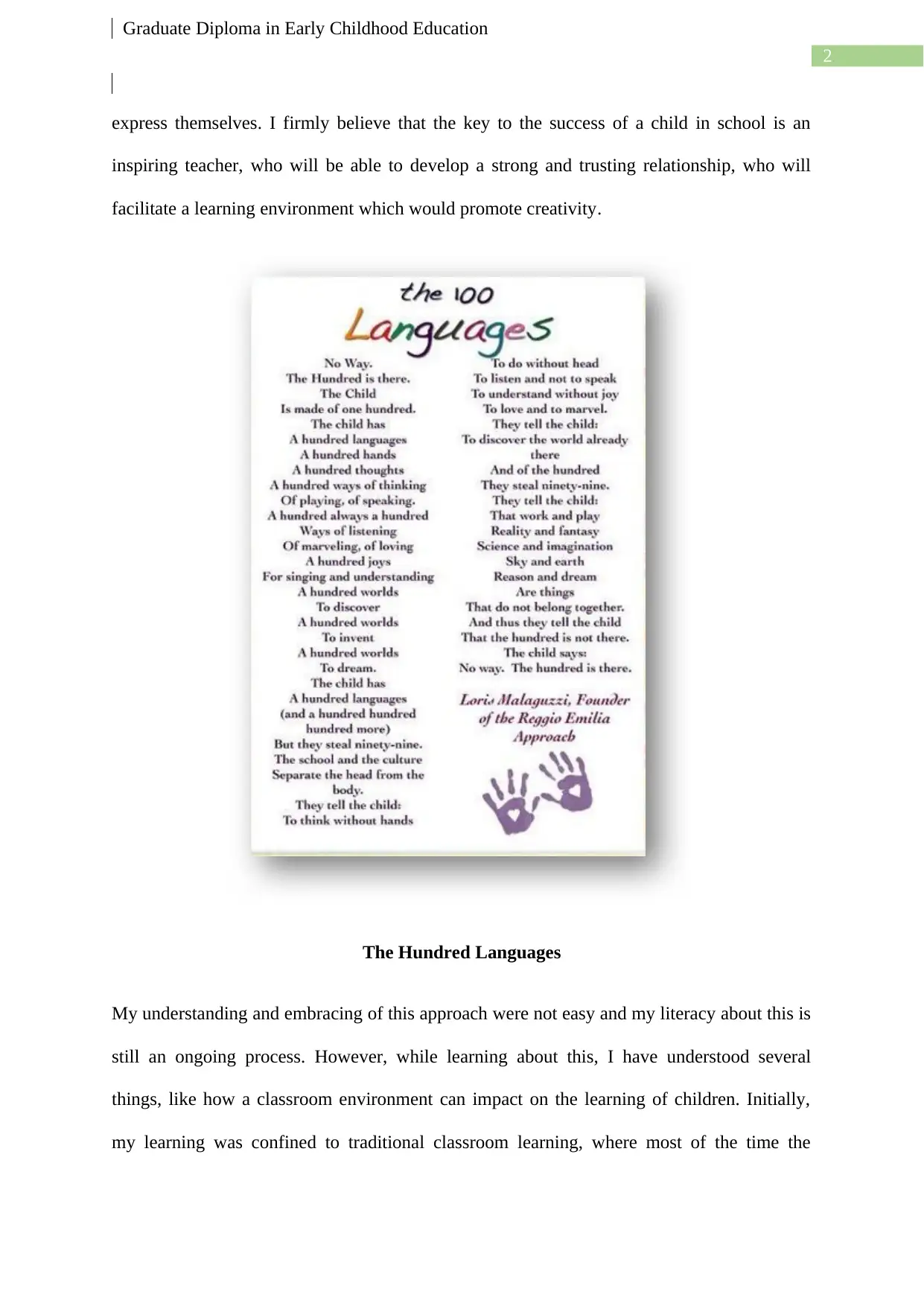
2
Graduate Diploma in Early Childhood Education
express themselves. I firmly believe that the key to the success of a child in school is an
inspiring teacher, who will be able to develop a strong and trusting relationship, who will
facilitate a learning environment which would promote creativity.
The Hundred Languages
My understanding and embracing of this approach were not easy and my literacy about this is
still an ongoing process. However, while learning about this, I have understood several
things, like how a classroom environment can impact on the learning of children. Initially,
my learning was confined to traditional classroom learning, where most of the time the
Graduate Diploma in Early Childhood Education
express themselves. I firmly believe that the key to the success of a child in school is an
inspiring teacher, who will be able to develop a strong and trusting relationship, who will
facilitate a learning environment which would promote creativity.
The Hundred Languages
My understanding and embracing of this approach were not easy and my literacy about this is
still an ongoing process. However, while learning about this, I have understood several
things, like how a classroom environment can impact on the learning of children. Initially,
my learning was confined to traditional classroom learning, where most of the time the
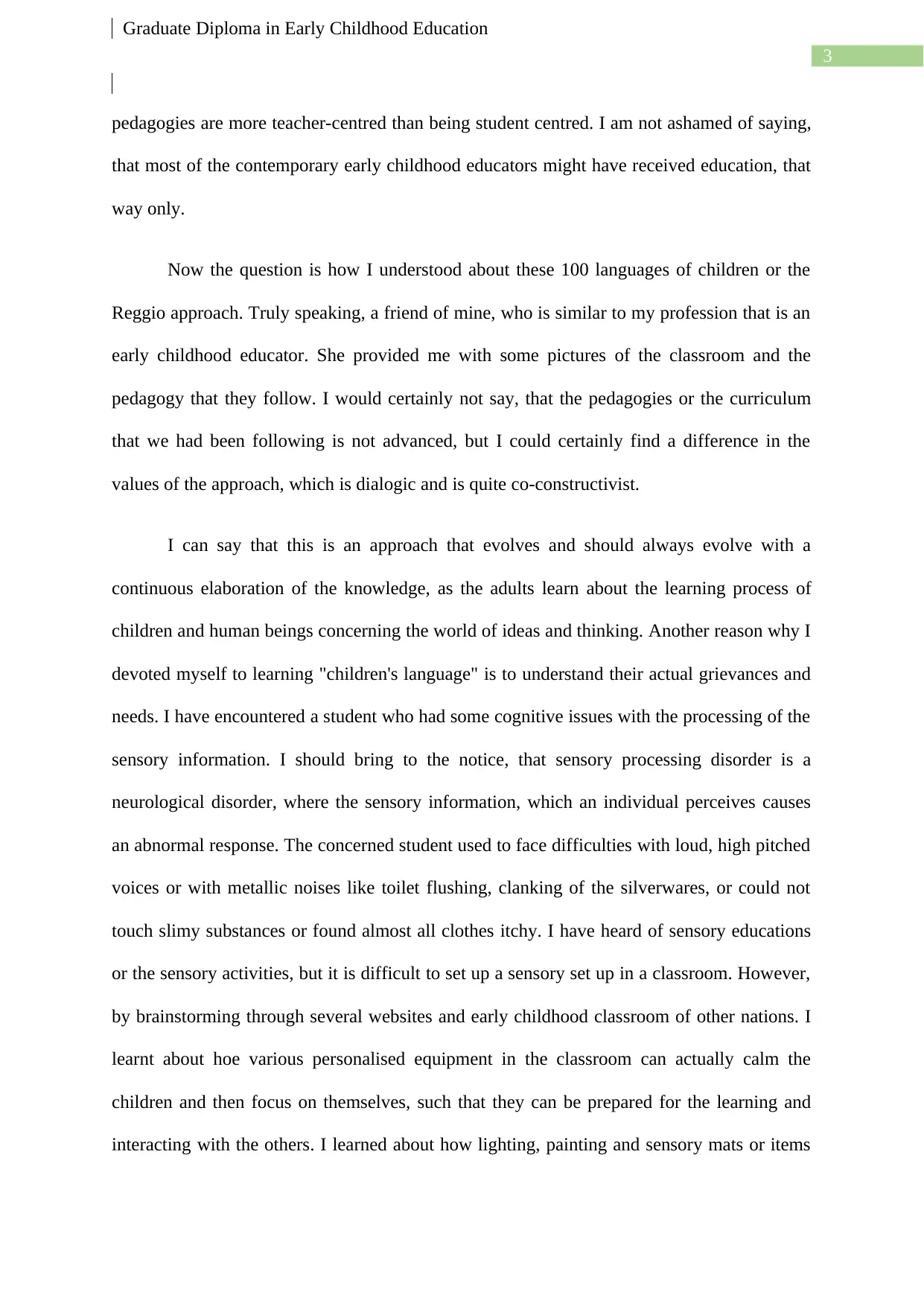
3
Graduate Diploma in Early Childhood Education
pedagogies are more teacher-centred than being student centred. I am not ashamed of saying,
that most of the contemporary early childhood educators might have received education, that
way only.
Now the question is how I understood about these 100 languages of children or the
Reggio approach. Truly speaking, a friend of mine, who is similar to my profession that is an
early childhood educator. She provided me with some pictures of the classroom and the
pedagogy that they follow. I would certainly not say, that the pedagogies or the curriculum
that we had been following is not advanced, but I could certainly find a difference in the
values of the approach, which is dialogic and is quite co-constructivist.
I can say that this is an approach that evolves and should always evolve with a
continuous elaboration of the knowledge, as the adults learn about the learning process of
children and human beings concerning the world of ideas and thinking. Another reason why I
devoted myself to learning "children's language" is to understand their actual grievances and
needs. I have encountered a student who had some cognitive issues with the processing of the
sensory information. I should bring to the notice, that sensory processing disorder is a
neurological disorder, where the sensory information, which an individual perceives causes
an abnormal response. The concerned student used to face difficulties with loud, high pitched
voices or with metallic noises like toilet flushing, clanking of the silverwares, or could not
touch slimy substances or found almost all clothes itchy. I have heard of sensory educations
or the sensory activities, but it is difficult to set up a sensory set up in a classroom. However,
by brainstorming through several websites and early childhood classroom of other nations. I
learnt about hoe various personalised equipment in the classroom can actually calm the
children and then focus on themselves, such that they can be prepared for the learning and
interacting with the others. I learned about how lighting, painting and sensory mats or items
Graduate Diploma in Early Childhood Education
pedagogies are more teacher-centred than being student centred. I am not ashamed of saying,
that most of the contemporary early childhood educators might have received education, that
way only.
Now the question is how I understood about these 100 languages of children or the
Reggio approach. Truly speaking, a friend of mine, who is similar to my profession that is an
early childhood educator. She provided me with some pictures of the classroom and the
pedagogy that they follow. I would certainly not say, that the pedagogies or the curriculum
that we had been following is not advanced, but I could certainly find a difference in the
values of the approach, which is dialogic and is quite co-constructivist.
I can say that this is an approach that evolves and should always evolve with a
continuous elaboration of the knowledge, as the adults learn about the learning process of
children and human beings concerning the world of ideas and thinking. Another reason why I
devoted myself to learning "children's language" is to understand their actual grievances and
needs. I have encountered a student who had some cognitive issues with the processing of the
sensory information. I should bring to the notice, that sensory processing disorder is a
neurological disorder, where the sensory information, which an individual perceives causes
an abnormal response. The concerned student used to face difficulties with loud, high pitched
voices or with metallic noises like toilet flushing, clanking of the silverwares, or could not
touch slimy substances or found almost all clothes itchy. I have heard of sensory educations
or the sensory activities, but it is difficult to set up a sensory set up in a classroom. However,
by brainstorming through several websites and early childhood classroom of other nations. I
learnt about hoe various personalised equipment in the classroom can actually calm the
children and then focus on themselves, such that they can be prepared for the learning and
interacting with the others. I learned about how lighting, painting and sensory mats or items
Secure Best Marks with AI Grader
Need help grading? Try our AI Grader for instant feedback on your assignments.
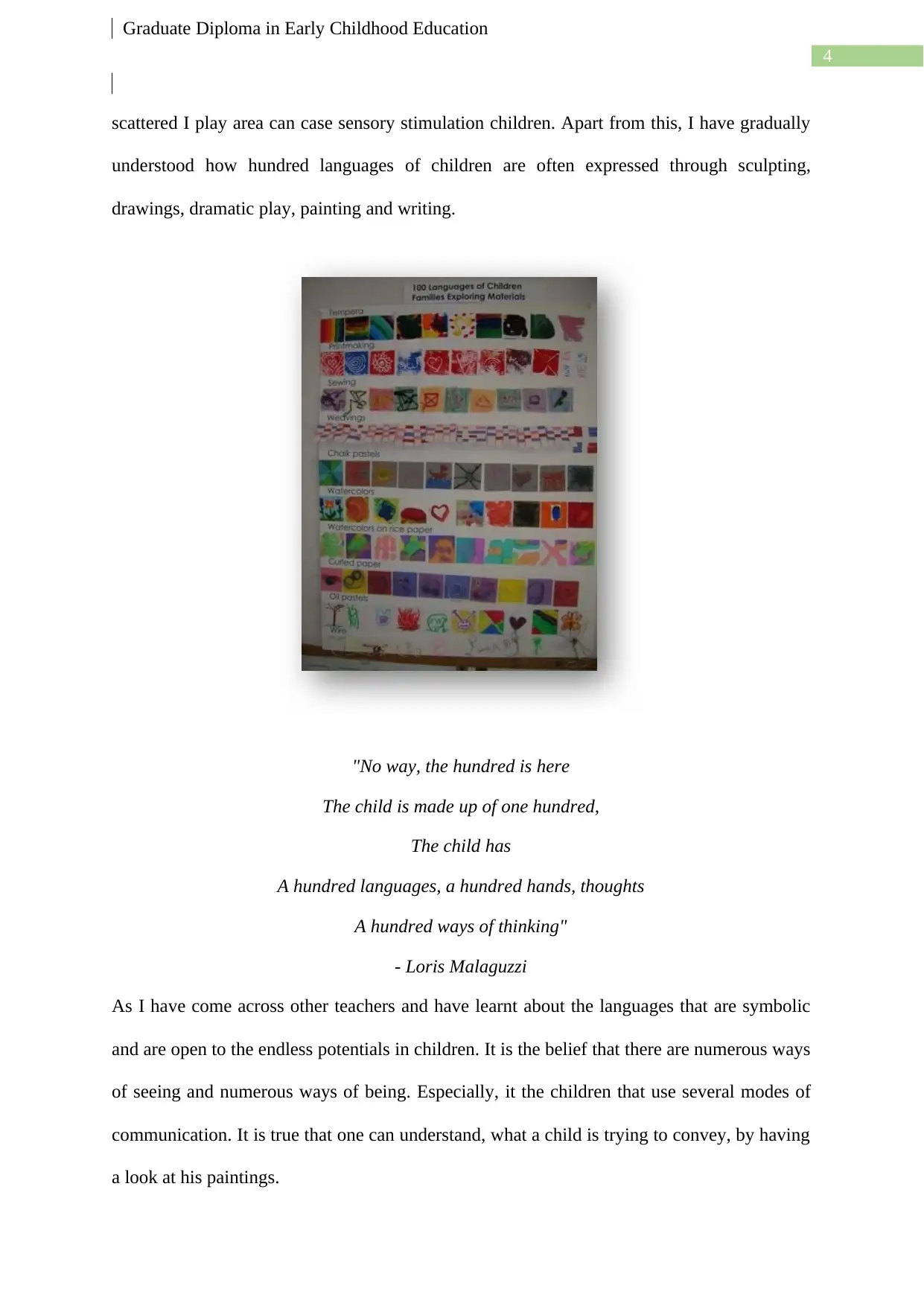
4
Graduate Diploma in Early Childhood Education
scattered I play area can case sensory stimulation children. Apart from this, I have gradually
understood how hundred languages of children are often expressed through sculpting,
drawings, dramatic play, painting and writing.
"No way, the hundred is here
The child is made up of one hundred,
The child has
A hundred languages, a hundred hands, thoughts
A hundred ways of thinking"
- Loris Malaguzzi
As I have come across other teachers and have learnt about the languages that are symbolic
and are open to the endless potentials in children. It is the belief that there are numerous ways
of seeing and numerous ways of being. Especially, it the children that use several modes of
communication. It is true that one can understand, what a child is trying to convey, by having
a look at his paintings.
Graduate Diploma in Early Childhood Education
scattered I play area can case sensory stimulation children. Apart from this, I have gradually
understood how hundred languages of children are often expressed through sculpting,
drawings, dramatic play, painting and writing.
"No way, the hundred is here
The child is made up of one hundred,
The child has
A hundred languages, a hundred hands, thoughts
A hundred ways of thinking"
- Loris Malaguzzi
As I have come across other teachers and have learnt about the languages that are symbolic
and are open to the endless potentials in children. It is the belief that there are numerous ways
of seeing and numerous ways of being. Especially, it the children that use several modes of
communication. It is true that one can understand, what a child is trying to convey, by having
a look at his paintings.
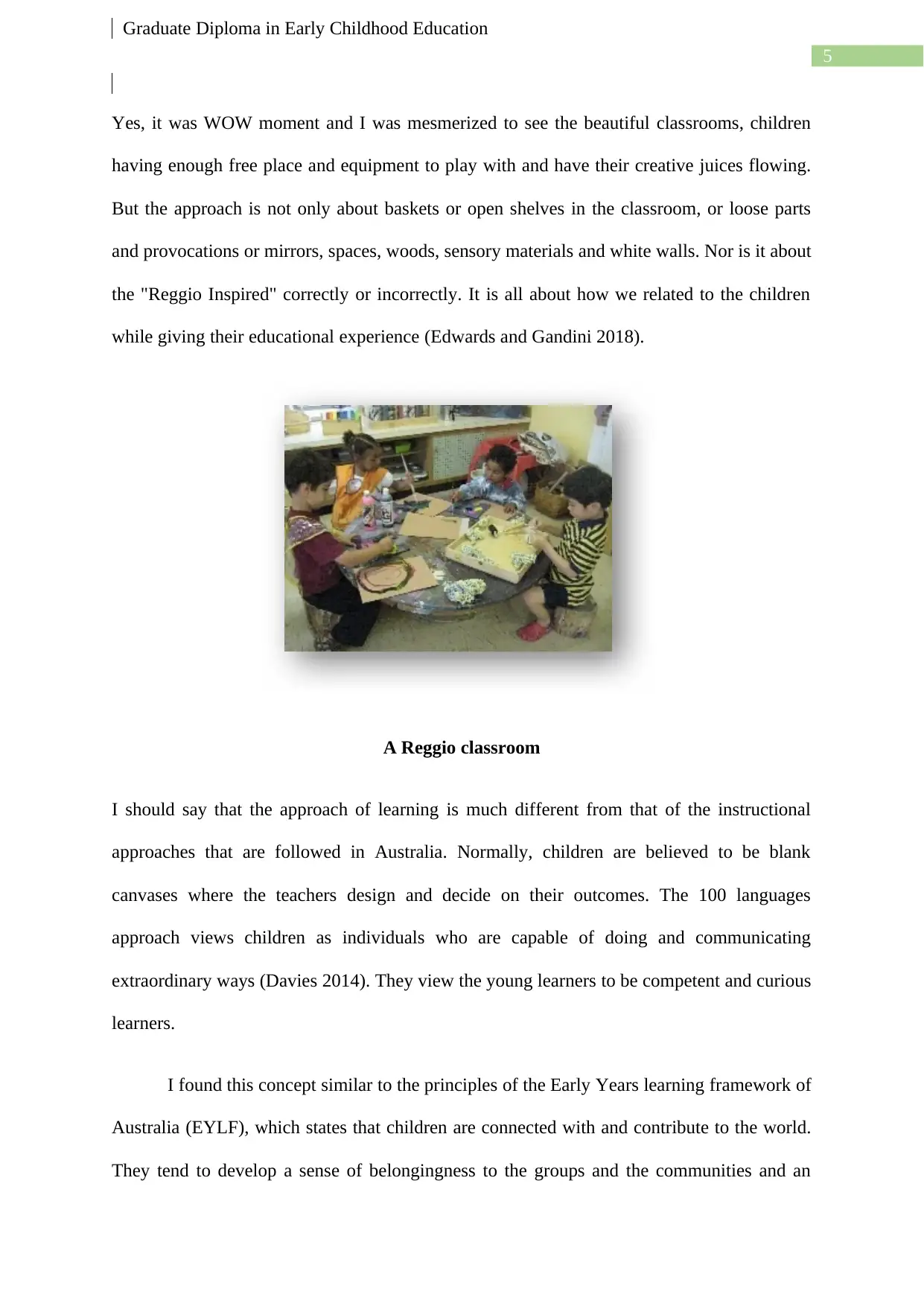
5
Graduate Diploma in Early Childhood Education
Yes, it was WOW moment and I was mesmerized to see the beautiful classrooms, children
having enough free place and equipment to play with and have their creative juices flowing.
But the approach is not only about baskets or open shelves in the classroom, or loose parts
and provocations or mirrors, spaces, woods, sensory materials and white walls. Nor is it about
the "Reggio Inspired" correctly or incorrectly. It is all about how we related to the children
while giving their educational experience (Edwards and Gandini 2018).
A Reggio classroom
I should say that the approach of learning is much different from that of the instructional
approaches that are followed in Australia. Normally, children are believed to be blank
canvases where the teachers design and decide on their outcomes. The 100 languages
approach views children as individuals who are capable of doing and communicating
extraordinary ways (Davies 2014). They view the young learners to be competent and curious
learners.
I found this concept similar to the principles of the Early Years learning framework of
Australia (EYLF), which states that children are connected with and contribute to the world.
They tend to develop a sense of belongingness to the groups and the communities and an
Graduate Diploma in Early Childhood Education
Yes, it was WOW moment and I was mesmerized to see the beautiful classrooms, children
having enough free place and equipment to play with and have their creative juices flowing.
But the approach is not only about baskets or open shelves in the classroom, or loose parts
and provocations or mirrors, spaces, woods, sensory materials and white walls. Nor is it about
the "Reggio Inspired" correctly or incorrectly. It is all about how we related to the children
while giving their educational experience (Edwards and Gandini 2018).
A Reggio classroom
I should say that the approach of learning is much different from that of the instructional
approaches that are followed in Australia. Normally, children are believed to be blank
canvases where the teachers design and decide on their outcomes. The 100 languages
approach views children as individuals who are capable of doing and communicating
extraordinary ways (Davies 2014). They view the young learners to be competent and curious
learners.
I found this concept similar to the principles of the Early Years learning framework of
Australia (EYLF), which states that children are connected with and contribute to the world.
They tend to develop a sense of belongingness to the groups and the communities and an
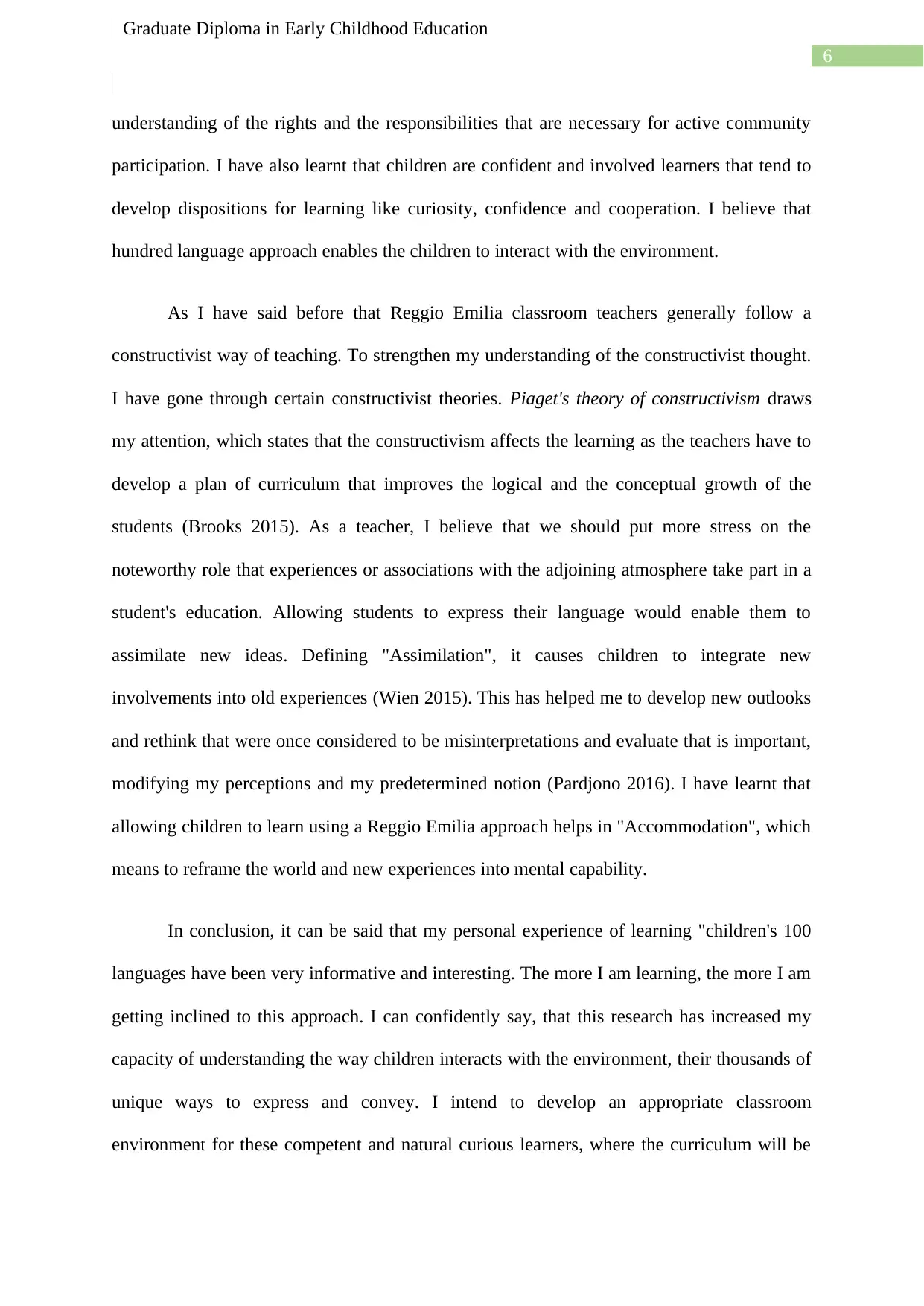
6
Graduate Diploma in Early Childhood Education
understanding of the rights and the responsibilities that are necessary for active community
participation. I have also learnt that children are confident and involved learners that tend to
develop dispositions for learning like curiosity, confidence and cooperation. I believe that
hundred language approach enables the children to interact with the environment.
As I have said before that Reggio Emilia classroom teachers generally follow a
constructivist way of teaching. To strengthen my understanding of the constructivist thought.
I have gone through certain constructivist theories. Piaget's theory of constructivism draws
my attention, which states that the constructivism affects the learning as the teachers have to
develop a plan of curriculum that improves the logical and the conceptual growth of the
students (Brooks 2015). As a teacher, I believe that we should put more stress on the
noteworthy role that experiences or associations with the adjoining atmosphere take part in a
student's education. Allowing students to express their language would enable them to
assimilate new ideas. Defining "Assimilation", it causes children to integrate new
involvements into old experiences (Wien 2015). This has helped me to develop new outlooks
and rethink that were once considered to be misinterpretations and evaluate that is important,
modifying my perceptions and my predetermined notion (Pardjono 2016). I have learnt that
allowing children to learn using a Reggio Emilia approach helps in "Accommodation", which
means to reframe the world and new experiences into mental capability.
In conclusion, it can be said that my personal experience of learning "children's 100
languages have been very informative and interesting. The more I am learning, the more I am
getting inclined to this approach. I can confidently say, that this research has increased my
capacity of understanding the way children interacts with the environment, their thousands of
unique ways to express and convey. I intend to develop an appropriate classroom
environment for these competent and natural curious learners, where the curriculum will be
Graduate Diploma in Early Childhood Education
understanding of the rights and the responsibilities that are necessary for active community
participation. I have also learnt that children are confident and involved learners that tend to
develop dispositions for learning like curiosity, confidence and cooperation. I believe that
hundred language approach enables the children to interact with the environment.
As I have said before that Reggio Emilia classroom teachers generally follow a
constructivist way of teaching. To strengthen my understanding of the constructivist thought.
I have gone through certain constructivist theories. Piaget's theory of constructivism draws
my attention, which states that the constructivism affects the learning as the teachers have to
develop a plan of curriculum that improves the logical and the conceptual growth of the
students (Brooks 2015). As a teacher, I believe that we should put more stress on the
noteworthy role that experiences or associations with the adjoining atmosphere take part in a
student's education. Allowing students to express their language would enable them to
assimilate new ideas. Defining "Assimilation", it causes children to integrate new
involvements into old experiences (Wien 2015). This has helped me to develop new outlooks
and rethink that were once considered to be misinterpretations and evaluate that is important,
modifying my perceptions and my predetermined notion (Pardjono 2016). I have learnt that
allowing children to learn using a Reggio Emilia approach helps in "Accommodation", which
means to reframe the world and new experiences into mental capability.
In conclusion, it can be said that my personal experience of learning "children's 100
languages have been very informative and interesting. The more I am learning, the more I am
getting inclined to this approach. I can confidently say, that this research has increased my
capacity of understanding the way children interacts with the environment, their thousands of
unique ways to express and convey. I intend to develop an appropriate classroom
environment for these competent and natural curious learners, where the curriculum will be
Paraphrase This Document
Need a fresh take? Get an instant paraphrase of this document with our AI Paraphraser
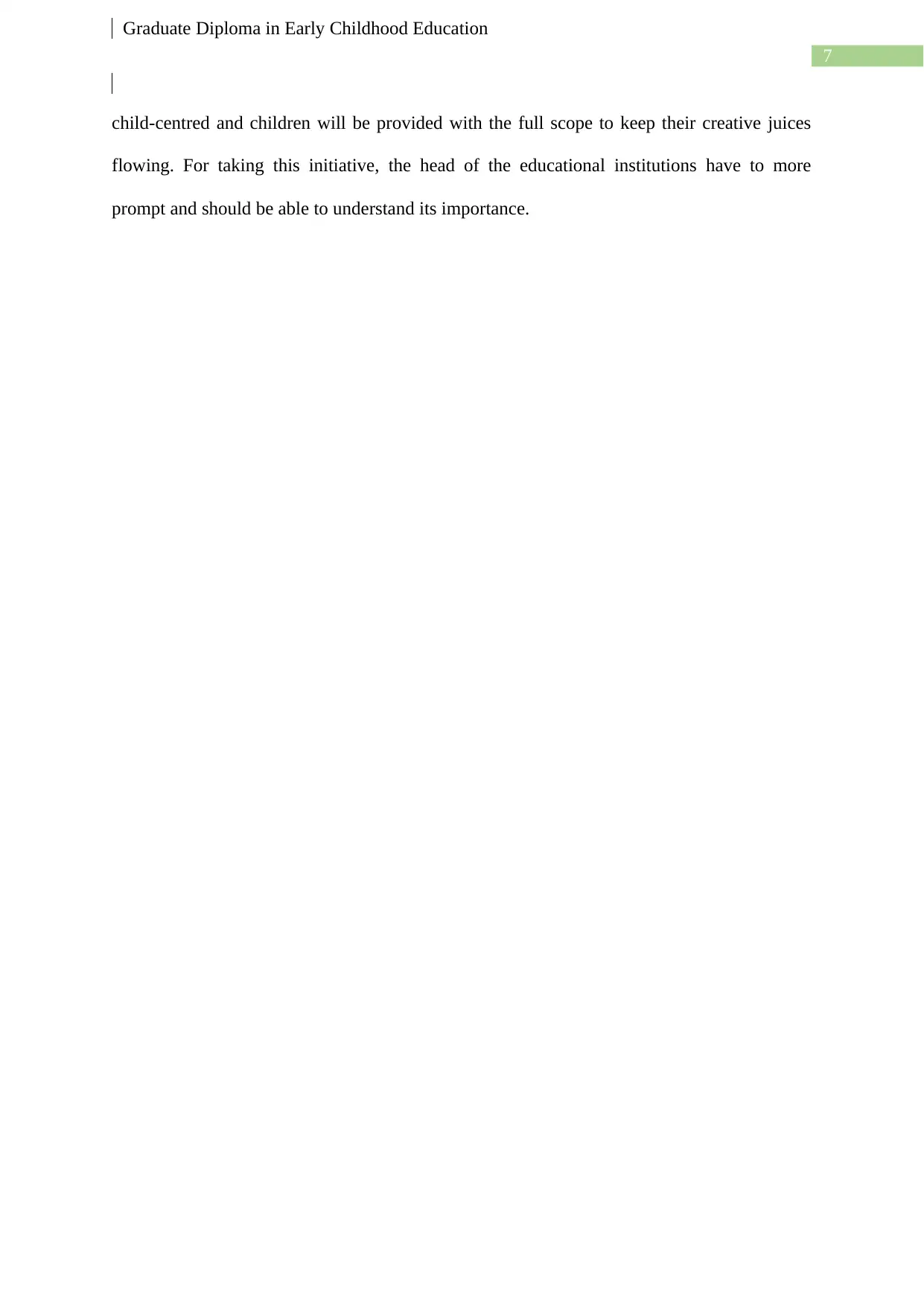
7
Graduate Diploma in Early Childhood Education
child-centred and children will be provided with the full scope to keep their creative juices
flowing. For taking this initiative, the head of the educational institutions have to more
prompt and should be able to understand its importance.
Graduate Diploma in Early Childhood Education
child-centred and children will be provided with the full scope to keep their creative juices
flowing. For taking this initiative, the head of the educational institutions have to more
prompt and should be able to understand its importance.
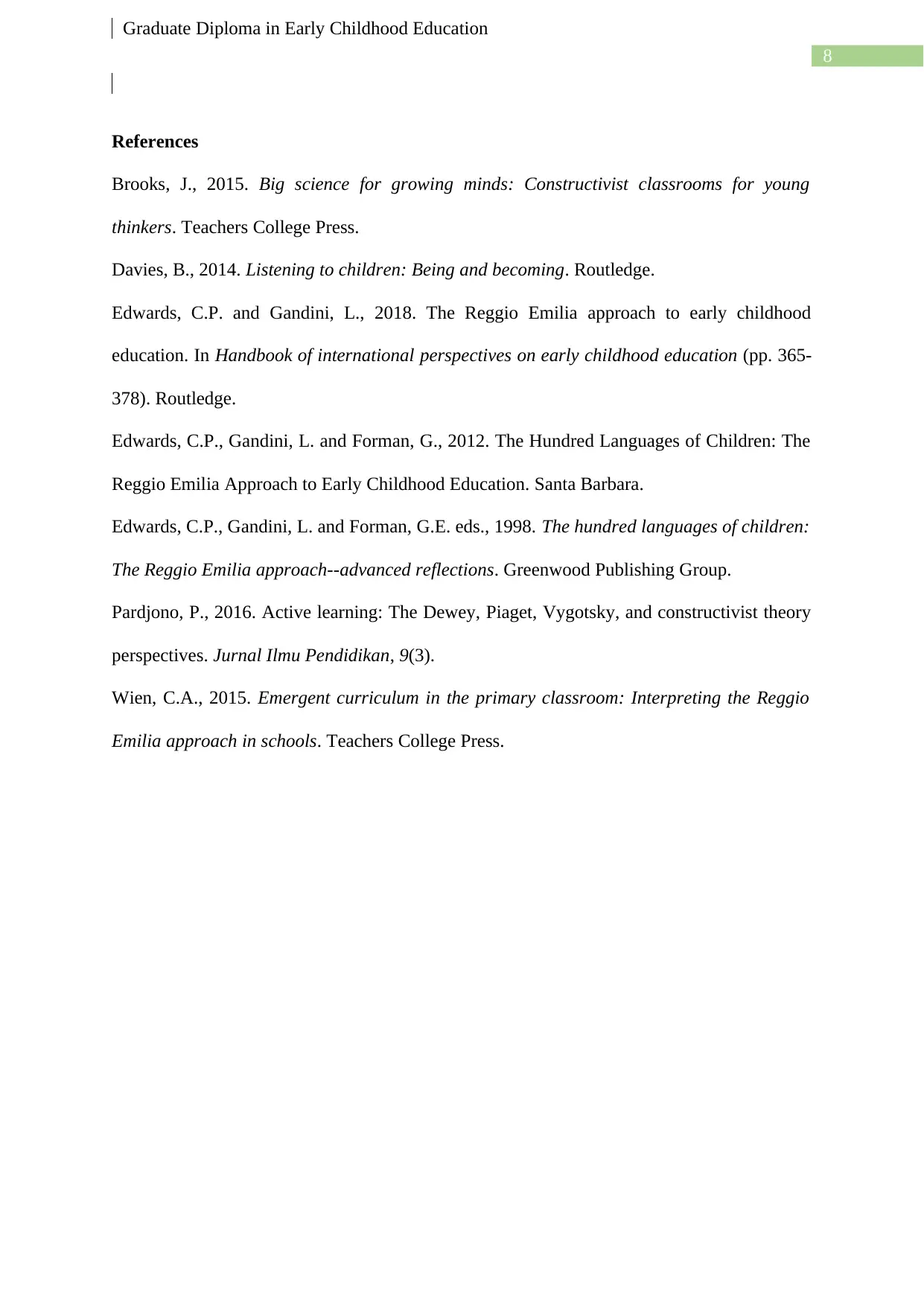
8
Graduate Diploma in Early Childhood Education
References
Brooks, J., 2015. Big science for growing minds: Constructivist classrooms for young
thinkers. Teachers College Press.
Davies, B., 2014. Listening to children: Being and becoming. Routledge.
Edwards, C.P. and Gandini, L., 2018. The Reggio Emilia approach to early childhood
education. In Handbook of international perspectives on early childhood education (pp. 365-
378). Routledge.
Edwards, C.P., Gandini, L. and Forman, G., 2012. The Hundred Languages of Children: The
Reggio Emilia Approach to Early Childhood Education. Santa Barbara.
Edwards, C.P., Gandini, L. and Forman, G.E. eds., 1998. The hundred languages of children:
The Reggio Emilia approach--advanced reflections. Greenwood Publishing Group.
Pardjono, P., 2016. Active learning: The Dewey, Piaget, Vygotsky, and constructivist theory
perspectives. Jurnal Ilmu Pendidikan, 9(3).
Wien, C.A., 2015. Emergent curriculum in the primary classroom: Interpreting the Reggio
Emilia approach in schools. Teachers College Press.
Graduate Diploma in Early Childhood Education
References
Brooks, J., 2015. Big science for growing minds: Constructivist classrooms for young
thinkers. Teachers College Press.
Davies, B., 2014. Listening to children: Being and becoming. Routledge.
Edwards, C.P. and Gandini, L., 2018. The Reggio Emilia approach to early childhood
education. In Handbook of international perspectives on early childhood education (pp. 365-
378). Routledge.
Edwards, C.P., Gandini, L. and Forman, G., 2012. The Hundred Languages of Children: The
Reggio Emilia Approach to Early Childhood Education. Santa Barbara.
Edwards, C.P., Gandini, L. and Forman, G.E. eds., 1998. The hundred languages of children:
The Reggio Emilia approach--advanced reflections. Greenwood Publishing Group.
Pardjono, P., 2016. Active learning: The Dewey, Piaget, Vygotsky, and constructivist theory
perspectives. Jurnal Ilmu Pendidikan, 9(3).
Wien, C.A., 2015. Emergent curriculum in the primary classroom: Interpreting the Reggio
Emilia approach in schools. Teachers College Press.
1 out of 9
Related Documents
Your All-in-One AI-Powered Toolkit for Academic Success.
+13062052269
info@desklib.com
Available 24*7 on WhatsApp / Email
![[object Object]](/_next/static/media/star-bottom.7253800d.svg)
Unlock your academic potential
© 2024 | Zucol Services PVT LTD | All rights reserved.





